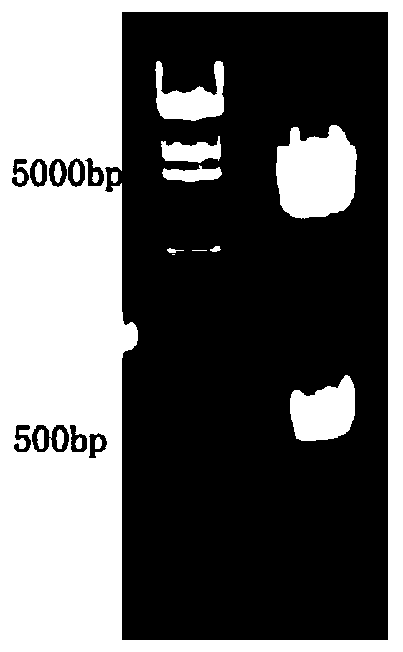Building method of PDGFB promoter activity report plasmids
A technology of reporter plasmid and construction method, which is applied in the field of construction of PDGFB promoter activity reporter plasmid to achieve the effect of promoting tumor and liver fibrosis
- Summary
- Abstract
- Description
- Claims
- Application Information
AI Technical Summary
Problems solved by technology
Method used
Image
Examples
Embodiment 1
[0028] A kind of construction method of PDGFB promoter activity reporter plasmid, described mouse PDGFB gene promoter sequence is as shown in SEQID:NO:1, construction method comprises the following steps:
[0029] S1. Extract the peripheral blood of normal mice, use the blood DNA extraction kit (available in various biological reagent companies, this experiment was purchased from Sangon Bioengineering (Shanghai) Co., Ltd.) to extract mouse genomic DNA, and test the DNA purity and backup for completeness;
[0030] S2, database search, the promoter sequence of the transcription start site (TSS) region of the mouse PDGFB gene with a length of 600bp (-499-100bp) is shown in SEQ ID: NO: 1;
[0031] S3, PCR amplification of the PDGFB gene promoter sequence, adding the corresponding restriction endonuclease sequence and protective bases at both ends of the primer; the sequence of KpnI is shown in SEQ ID: NO: 3, and the sequence of Hind III is shown in SEQ ID: NO: 4 shown; the sequen...
Embodiment 2
[0040] S11. Plasmid identification step: the plasmid constructed in step S10 was preliminarily identified by restriction endonuclease double digestion, and further sent to Shanghai Invitrogen Company for sequencing to sequence the constructed plasmid, and named it pPDGFB-luc to construct the plasmid The sequence, that is, the sequence of pPDGFB-luc is shown in SEQ ID: NO:2.
[0041] Such as figure 1 As shown, the above-mentioned plasmid was digested with Kpn I and Hind III and then detected by agarose gel electrophoresis to obtain two bands of about 600bp and about 5000bp, which can be used for preliminary verification of the plasmid constructed in the present invention, and then confirmed by further sequencing. The plasmid sequence is correct.
Embodiment 3
[0043] S12. The function of the constructed plasmid was verified by detecting the promoter luciferase activity after transfecting mouse HSCs cells. The results further confirmed that the constructed PDGFB promoter activity reporter plasmid pPDGFB-luc was functional and used for the PDGFB promoter active research.
[0044] In the step S12, verifying the function of constructing the plasmid by detecting the promoter luciferase activity after transfecting the mouse HSCs cells includes the following steps: inoculating the mouse HSCs cells on a 12-well plate one day before the transfection, and culturing until the cell density reaches About 70%. Dilute 1.6 ug plasmid and 30 ng renilla with 300 ul Optin-MEM, according to the Lipo 2000 liposome transfection reagent instructions, respectively pPDGFB-luc (constructed in step S10) and pGL3-Basic-vector (negative control group) Transfected into cells, set up 3 duplicate wells. After 24 hours, the cells were collected using the dual flu...
PUM
 Login to View More
Login to View More Abstract
Description
Claims
Application Information
 Login to View More
Login to View More - R&D
- Intellectual Property
- Life Sciences
- Materials
- Tech Scout
- Unparalleled Data Quality
- Higher Quality Content
- 60% Fewer Hallucinations
Browse by: Latest US Patents, China's latest patents, Technical Efficacy Thesaurus, Application Domain, Technology Topic, Popular Technical Reports.
© 2025 PatSnap. All rights reserved.Legal|Privacy policy|Modern Slavery Act Transparency Statement|Sitemap|About US| Contact US: help@patsnap.com


